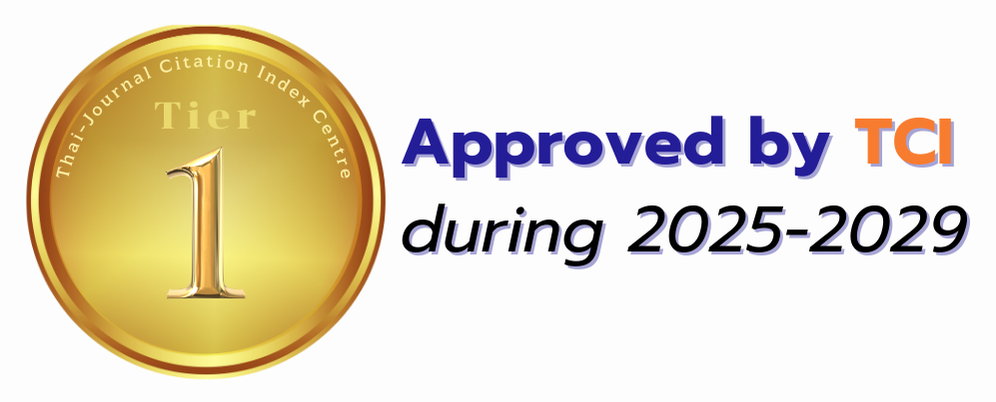Integration of Google Earth and a Spreadsheet (LESS-FOR-01) to Create an Online Tree-Level Carbon Storage Map at Khao Nam Sub, Kasetsart University Sriracha Campus, Chonburi Province
DOI:
https://doi.org/10.34044/tferj.2025.9.2.6421Keywords:
Google Earth, Spreadsheet, Interactive map, Tree carbon storage, Nature trailAbstract
Background and Objectives: Climate change has become a critical global issue affecting ecosystems worldwide, especially forests, which play a key role in carbon sequestration. While assessments often focus on large forests, small green spaces such as green university, nature trails, and urban green areas—also contribute to carbon storage and serve as platforms for environmental education. This study aimed to assess carbon storage of individual trees and generate spatially interactive carbon map the Khao Nam Sub Forest area at Kasetsart University, Sriracha Campus, Chonburi Province. This knowledge can apply the sustainable management of urban small green areas, including serve as a database for supporting environmental learning, as well as to supports the Sustainable Development Goals (SDGs 13 and 15) and aligns with Thailand’s Bio-Circular-Green (BCG) Economy Model.
Methodology: The study was conducted within Khao Nam Sub area comprising dry evergreen forest (DEF) and mixed deciduous forest (MDF) types. Field data were collected along two designated nature trails: the summit trail (1.5 km) and the foothill loop trail (2.5 km), during August–October 2024. All trees and lianas with a diameter at breast height (DBH) ≥ 4.5 cm were identified, measured for DBH and total height, and georeferenced using the WGS84 coordinate system via the Google Earth mobile application. Some morphological characteristics were also photographed. Aboveground biomass (AGB) was estimated using forest-type-specific allometric equations, and belowground biomass (BGB) was derived as 0.27 × AGB. Carbon stock was calculated as 47% of total biomass (AGB + BGB) and expressed in tones of CO₂ equivalent (tCO₂e). The integrated application between Google Earth and Spreadsheet LESS-FOR-01Version 6 which developed by Thailand Greenhouse Gas Management Organization (TGO) was used to create the interactive map that included information of scientific names, GBH, carbon values, and morphological images of each tree in both 2D and 3D formats. The research was done during August to October 2024.
Main Results: A total of 467 individual trees and climbing lianas were recorded along two designated nature trails, representing 70 species, 59 genera, and 33 families, indicating relatively high species richness within the study area. The most abundant climbing species was Lasiobema scandens. Across all individuals, the average diameter at breast height (DBH) was 15.40 ± 8.00 cm, and the average height was 8.76 ± 4.21 m, reflecting a structurally mixed stand composed of both small and maturing tree stages. The estimated total tree biomass for the entire surveyed area was 61.56 tons, comprising 48.47 tons of aboveground biomass (AGB) and 13.09 tons of belowground biomass. This corresponded to a total carbon stock of 28.93 tons carbon (tC), or 106.07 tons of CO₂-equivalent (tCO₂e). Upon analysis, clear structural differences were evident. The Summit trail contained the highest number of individuals (321 stems representing 48 species), which were mostly small in size, with a mean DBH of 14.37 ± 7.47 cm and a mean height of 7.89 ± 2.45 m. The total biomass was 31.51 tons (24.81 tons AGB and 6.70 tons BGB), storing 14.81 tC or 54.29 tCO₂e. In contrast, the Foothill trail contained fewer trees (146 stems from 52 species), but trees were generally larger and taller, with a mean DBH of 17.87 ± 8.16 cm and a mean height of 10.65 ± 5.04 m. Its total biomass was 30.05 tons (23.66 tons AGB and 6.39 tons BGB), sequestering 14.12 tC or 51.78 tCO₂e. Despite the smaller number of individuals, the foothill trail showed comparable carbon stocks to the summit trail, highlighting the greater influence of large-sized trees on carbon storage compared with high densities of small-sized trees. The forest composition and structure along both routes reflect a transitional mosaic of DEF and MDF tree species, with stratified canopy layers and varied stem sizes indicating ongoing regeneration and partial recovery from past disturbance. However, the accumulated carbon stock was lower compared with estimates from full-plot assessments of the entire Khao Nam Sub Forest. This discrepancy may be attributed to several limitations, including measurement uncertainties of tree height measured, the use of a fixed root-to-shoot ratio (0.27), and the linear-based sampling design along nature trails, which access forest edges and cannot fully represent the entire landscape. Although the positional accuracy of Google Earth Mobile depends on mobile signal quality, it proved suitable for generating interactive mapping and spatial visualization in the Khao Nam Sub Forest. The resulting map enables users to easily and clearly access tree-specific information along the nature trails, including scientific name, GBH, total height, carbon stock, and morphological images, with georeferenced positions displayed in both 2D and 3D formats. Such tools facilitate participatory learning, future research applications, and effective management of small-scale green spaces.
Conclusion: Integrating Google Earth with the LESS-FOR-01 spreadsheet proved to be an effective method for assessing and visualizing tree-level carbon storage in small green areas. The resulting interactive Tree Carbon Storage Map enhances the assessment of carbon sequestration potential at a micro-scale level and spatial-based learning while raising awareness of each tree’s contribution to carbon storage in an ecosystem. This low-cost and replicable approach provides practical support for green space management, environmental education, and Thailand’s pursuit of Carbon Neutrality and the Sustainable Development Goals (SDGs 13 and 15) within academic institutions and local communities.
Downloads
References
Cardinale, B. J., J. E. Duffy, A. Gonzalez, D. U. Hooper, C. Perrings, P. Venail, & S. Naeem. 2012. Biodiversity loss and its impact on humanity. Nature 486(7401): 59–67. https://doi.org/10.1038/nature11148
Chavan, S. B., A. Keerthika, S. K. Dhyani, A. K. Handa, R. Newaj, K. Rajarajan, & R. Prasad. 2020. National agroforestry policy in India: A low hanging fruit for carbon sequestration to meet INDCs and SDGs. Environmental Sustainability 3(1): 5–17. https://doi.org/10.1007/s42398-020-00094-1
Chazdon, R. L. & P. H. S. Brancalion. 2019. Restoring forests as a means to many ends. Science 365(6448): 24–25. https://doi.org/10.1126/science.aax9539
Chazdon, R. L. 2014. Second growth: The promise of tropical forest regeneration in an age of deforestation. Chicago, IL: University of Chicago Press. https://doi.org/10.7208/chicago/9780226118109.001.0001
Chen, B., M. Artmann & Q. Zhou. 2022. Contrasting inequality in human exposure to greenspace: A cross-continental analysis of 1,028 cities. Nature Communications 13: 32258. https://doi.org/10.1038/s41467-022-32258-4
Chuanpeng, L., Y. Zhang, X. Wei & C. Huang. 2024. Deep learning–based tree species identification and mapping for biodiversity monitoring using high-resolution remote sensing. Ecological Indicators 160: 112114. https://doi.org/10.1016/j.ecolind.2023.112114
Deng, C., C. Wu, J. Li, R. Chen, L. Wang & G. Li. 2021. Integration of Google Earth Pro and field inventory for efficient urban green space mapping and management. Urban Forestry & Urban Greening 61: 127103. https://doi.org/10.1016/j.ufug.2021.127103
FAO. 2022. State of the World’s Forests 2022: Forest pathways for green recovery and building inclusive, resilient and sustainable economies. Rome: Food and Agriculture Organization of the United Nations. https://doi.org/10.4060/cb9360en
Field, A. 2013. Discovering statistics using IBM SPSS statistics. 4th ed. London: SAGE.
Griscom, B. W., J. Adams, P. W. Ellis, R. A. Houghton, G. Lomax, D. A. Miteva, & J. Fargione. 2017. Natural climate solutions. Proceedings of the National Academy of Sciences of the United States of America 114(44): 11645–11650. https://doi.org/10.1073/pnas.1710465114
Intergovernmental Panel on Climate Change (IPCC). 2006. 2006 IPCC Guidelines for National Greenhouse Gas Inventories. Volume 4: Agriculture, Forestry and Other Land Use (AFOLU). Hayama, Japan: Institute for Global Environmental Strategies (IGES). Available source: https://www.ipcc-nggip.iges.or.jp/public/2006gl/index.html (Accessed: July 10, 2025)
Intergovernmental Panel on Climate Change (IPCC). 2021. Climate Change 2021: The Physical Science Basis. Contribution of Working Group I to the Sixth Assessment Report of the Intergovernmental Panel on Climate Change. Cambridge: Cambridge University Press. https://doi.org/10.1017/9781009157896
Kumar, P., K. Okabe, J. M. Tylianakis, E. G. Brockerhoff, N. A. Schellhorn & T. Takahashi. 2023. Digital forest monitoring for climate-smart forestry and biodiversity conservation. Forest Ecology and Management 543: 121139. https://doi.org/10.1016/j.foreco.2023.121139
Le Quéré, C., P. Friedlingstein, J. G. Canadell, S. Sitch, J. Pongratz, P. Ciais, & D. Zhu. 2019. Global carbon budget 2018. Earth System Science Data 11: 1783–1838. https://doi.org/10.5194/essd-11-1783-2019
Marod, D., S. Sangkaew, A. Panmongkol & A. Jingjai. 2014. Influences of environmental factors on tree distribution of lower montane evergreen forest at Doi Sutep-Pui National Park, Chiang Mai Province. Thai Journal of Forestry 33(3): 23–33. (in Thai). https://li01.tci-thaijo.org/index.php/tjf/article/view/255453
Marod, D., S. Thinkamphaeng, J. Thongsawi, W. Phumphuang, T. Kokoet, S. Hermhuk & A. Nakthanom. 2018. Forest structure and species composition in the dry evergreen forest at Wang Nam Khiao Forestry Student Training and Research Station, Nakhon Ratchasima province. Thai Forest Ecological Research Journal, 2(1): 45-54. (in Thai). https://kuojs.lib.ku.ac.th/index.php/tferj/ article/view/6191
Mokopena, T., P. W. Chirwa, D. J. Gumbo & C. Wekesa. 2021. Carbon sequestration potential of small urban and peri-urban forests: Evidence from Southern Africa. Urban Forestry & Urban Greening 63: 127188. https://doi.org/10.1016/j.ufug.2021.127188
Nowak, D. J., A. R. Bodine, R. E. Hoehn, A. Ellis, S. Hirabayashi, A. K. Koeser & D. McLean. 2023. Carbon storage and annual sequestration by trees in urban and community areas of the conterminous United States. Environmental Research Letters 18(7): 074040. https://doi.org/10.1088/1748-9326/acd7d0
Nowak, D. J., E. J. Greenfield, R. E. Hoehn & E. LaPoint. 2013. Carbon storage and sequestration by trees in urban and community areas of the United States. Environmental Pollution 178: 229–236. https://doi.org/10.1016/j.envpol.2013.03.019
Office of Natural Resources and Environmental Policy and Planning (ONEP). 2021. Thailand Climate Change Master Plan 2021–2030. Bangkok: Ministry of Natural Resources and Environment. (in Thai). Available source: https://www.onep.go.th (Accessed: July 10, 2025)
Ogawa, H., K. Yoda, K. Ogino & T. Kira. 1965. Comparative ecological studies on three main types of forest vegetation in Thailand. II. Plant biomass. Nature and Life in Southeast Asia 4: 49–80.
Poorter, L., F. Bongers, T. M. Aide, A. M. A. Zambrano, P. Balvanera, J. M. Becknell, & R. L. Chazdon. 2016. Biomass resilience of Neotropical secondary forests. Nature 530(7589): 211–214. https://doi.org/10.1038/nature16512
Poorter, L., F. Bongers, T. M. Aide, A. M. A. Zambrano, P. Balvanera, J. M. Becknell, & R. L. Chazdon. 2021. Multidimensional tropical forest recovery. Science 374(6573): 1370–1376. https://doi.org/10.1126/science.abh3629
Royal Thai Government. 2023. Bio-Circular-Green (BCG) Economy Model. Bangkok: Office of the National Higher Education Science Research and Innovation Policy Council. (in Thai). https://www.nxpo.or.th/en/?p=12639
Smitinand, T. 2014. Thai plant names: Revised edition 2014. Bangkok: Forest Herbarium, Department of National Parks, Wildlife and Plant Conservation. (in Thai).
Song, X. P., P. Y. Tan, P. Edwards & D. Richards. 2018. The economic benefits and costs of trees in urban forest stewardship: A systematic review. Ecological Indicators 91: 301–317. https://doi.org/10.1016/j.ecolind.2018.03.070
Thai Meteorological Department. 2024. Climate statistics of Thailand 2024. Bangkok: Thai Meteorological Department. (in Thai). Available source: https://www.tmd.go.th (Accessed: July 10, 2025)
Thailand Greenhouse Gas Management Organization (Public Organization) (TGO). 2022. LESS-FOR-01: Spreadsheet for calculating tree-level carbon storage. Bangkok, Thailand. (in Thai). Available source: https://www.tgo.or.th (Accessed: July 10, 2025)
Thailand Greenhouse Gas Management Organization (Public Organization) (TGO). 2023. LESS-FOR-01: Spreadsheet for calculating tree-level carbon storage, Version 6. Bangkok, Thailand. (in Thai). Available source: https://www.tgo.or.th (Accessed: July 10, 2025)
Thinkampheang, S., N. Punthunan, T. Korkerd, R. Saikhammoon, C. Yatar, C. Sawasmongkol & W. Phumphuang. 2025. Forest structure and potential of carbon storage at Khao Nam Sab, Kasetsart University, Sri Racha Campus, Chonburi Province. Thai Forest Ecological Research Journal 9(1): 73–92. https://doi.org/10.34044/tferj.2025.9.1.6291
Thompson, I. D., K. Okabe, J. M. Tylianakis, P. Kumar, E. G. Brockerhoff, N. A. Schellhorn & T. Takahashi. 2021. Forest biodiversity and ecosystem services: A global perspective. Nature Sustainability 4: 720–734. https://doi.org/10.1038/s41893-021-00706-4
Tsutsumi, T., K. Yoda, P. Sahunalu, P. Dhanmanonda & B. Prachaiyo. 1983. Forest: Foliage, biomass and productivity in dry tropical forests of Thailand. Journal of Ecology 71(2): 439–454. https://doi.org/10.2307/2259729







.png)





